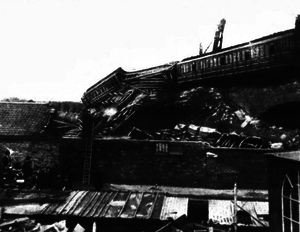Grantham rail accident
 Only the rearmost three carriages remained on the track | |
| Date | 19 September 1906 |
|---|---|
| Time | 23:04 |
| Location | Grantham, Lincolnshire |
| Coordinates | 52°54′35″N 0°38′48″W / 52.9097°N 0.6467°WCoordinates: 52°54′35″N 0°38′48″W / 52.9097°N 0.6467°W |
| Country | England |
| Rail line | East Coast Main Line |
| Cause | Runaway/Overspeed on curve/SPAD |
| Statistics | |
| Trains | 1 |
| Deaths | 14 |
| Injuries | 17 |
| List of UK rail accidents by year | |
The Grantham rail accident occurred on 19 September 1906. An evening Sleeping-Car and Mail train from London Kings Cross to Edinburgh Waverley hauled by Ivatt 'Atlantic' No 276 derailed, killing 14. The accident occurred in mysterious circumstances; the train ran right through Grantham station, where it was scheduled to stop, and derailed on a sharp junction curve at the end of the platform, which at the time had been set for the passing of a freight train; no definite cause was ever established as to why the train did not stop as scheduled or obey the signals at Caution and Danger. Rolt (1956) described it as "the railway equivalent of the mystery of the Marie [sic] Celeste".
Events
Late in the night of 19 September, the Semi-Fast Mail train was due to stop at Grantham. The signalman at Grantham south had his Down Distant signal at Caution and the signalman at Grantham North had all of his down signals at Danger to protect the passing of a goods train from the up Nottingham line to the up main line - crossing the down main line (the line on which the Mail was running). It was a clear night, with patchy rain, but the red eyes of the signal lamps burned bright in the darkness. The Mail roared towards the station, apparently missing the distant signal at Caution. When the headlights appeared at the end of the platform, it appeared to be going much too fast to stop, and some mistook it for a run through, not realising that the train had to stop because of the junction points. Much to the alarm of the postal sorters and the station staff who realised it was the Mail train, it sped towards Grantham North box where the points were set against it. A loud explosion was heard and fire lit up the entire North yard. The locomotive rode the curve but on the reverse curve following it the long tender derailed and swept away the parapet of an underbridge for 65 yards, before falling off the edge of it. In doing so, it derailed the locomotive which was slung broadside across both tracks. The carriages ran down the embankment after the bridge, and only the last three remained undamaged.
Possible causes
Many possible explanations were put forward, such as the driver going mad, being drunk, taken ill or having a fight with the fireman. The evidence of the signalman at Grantham was that he had seen both men standing looking forward through the cab front windows, apparently calmly. The platform staff were sure that the brakes on the train were not applied and that it was travelling at speeds over 40 mph. One possibility is that the driver had a seizure or "micro-sleep" and the inexperienced fireman did not realise until too late. Another, proposed in 2006 in the Railway Magazine, is a brake failure due to incorrect procedures when the engine was changed at the previous stop, Peterborough. The fireman was a trainee "Premium Apprentice" and might not have realised the importance of ensuring that the train brakes were working when reconnected. Automatic vacuum brakes were fitted on all passenger trains, so if any air entered the brake pipes due to a failed connection, the brakes would be automatically applied. The mystery still remains, not least because a number of Great Northern footplate men testified that the approach to Grantham was unmistakable.
Other derailments
The accident was the second in a series of three derailments due to excessive speed at night in a 16-month period. The others were at Salisbury (1906) and Shrewsbury (1907). All three resulted in deaths, including the footplate crews; the cause in each case was recorded as 'driver error' but there has been much speculation since.
See also
Other derailments in which the driver's momentary loss of attention was or may have been a factor:
- Bourne End rail crash
- December 2013 Spuyten Duyvil derailment
- Lists of rail accidents
- List of British rail accidents
References
- Rolt, L.T.C. (1956 (and later editions)). Red for Danger. Bodley Head / David and Charles / Pan Books /Alan Sutton Publishing. ISBN 978-0-7509-2047-6. Check date values in:
|date=(help) - Hamilton, J.A.B. (1967). British Railway Accidents of the 20th Century (reprinted as Disaster down the Line). George Allen and Unwin / Javelin Books. ISBN 0-7137-1973-7.
- Bonnett, H.: The Grantham Railcrash of 1906. Bygone Grantham, 1978. ISBN 0 906338 05 0
- Nock, O.S. (1980). Historic Railway Disasters (2nd ed.). Ian Allan. ISBN 978-0-7110-1752-8.
- The Railway Magazine, September and October 2006 issues (main article and discussion).
- "Lincolnshire County Council web page based on The Railway magazine story".
- Railways Archive: copy of the official report